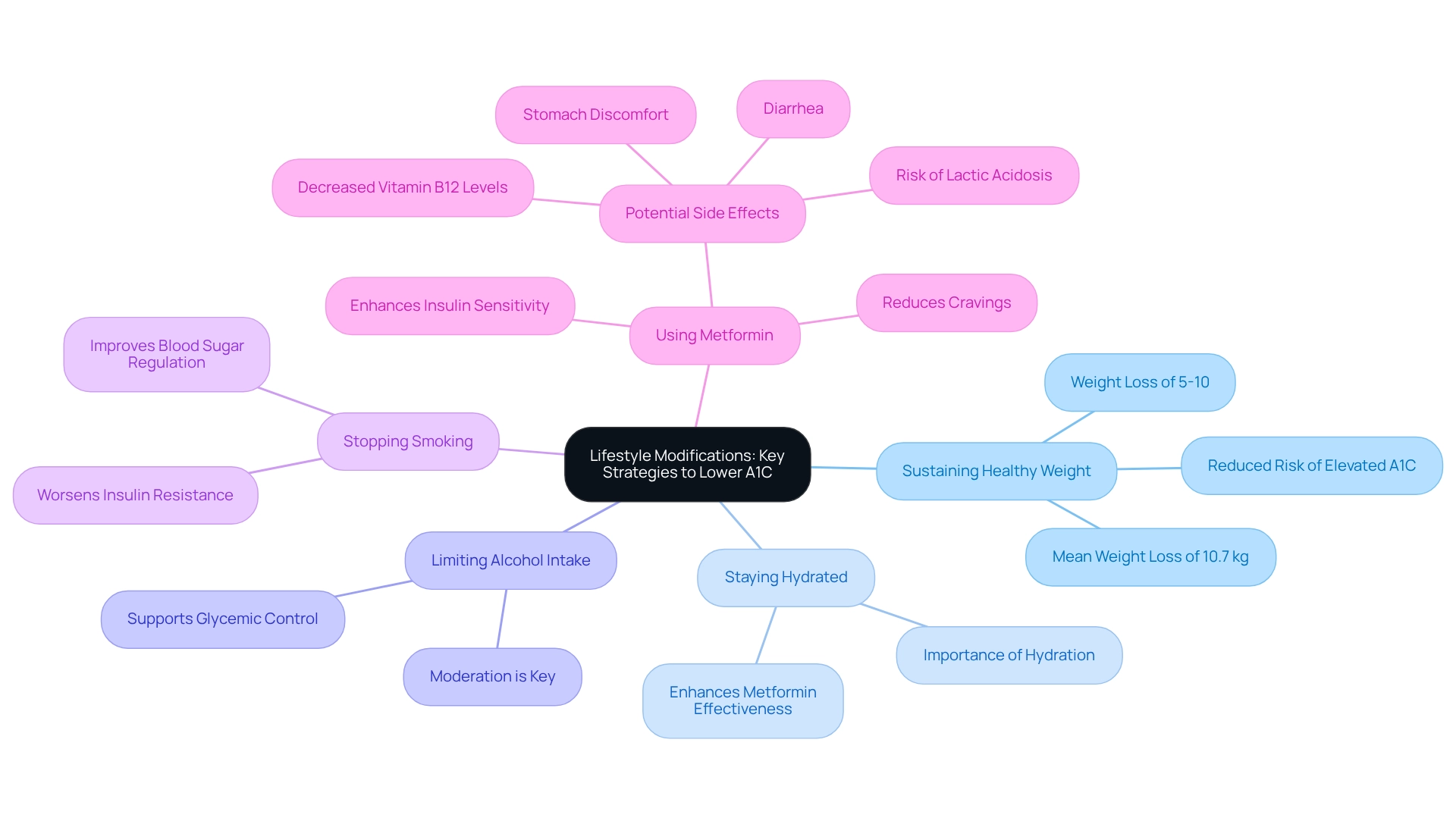Overview
If you’re looking to lower your A1C, know that you’re not alone on this journey. The fastest way to achieve this involves a combination of lifestyle modifications that can feel overwhelming at times. Maintaining a healthy weight, engaging in regular exercise, and following a balanced diet can make a significant difference. Additionally, medications like Metformin may also be beneficial for you.
Research supports these strategies, showing their effectiveness in managing blood sugar levels. It’s crucial to understand that these steps are not just about numbers; they are essential for achieving and maintaining optimal A1C values. By doing so, you can also reduce the risk of diabetes-related complications.
Remember, we’re here for you. Together, we can achieve your goals and create a healthier future. Embrace these changes with compassion for yourself, and take it one step at a time. You have the power to make a positive impact on your health.
Introduction
In the realm of diabetes management, understanding A1C levels is paramount. This vital blood test not only reflects average blood sugar levels over the past few months but also serves as a key indicator for long-term health outcomes. Did you know that nearly 13% of adults in the U.S. are grappling with diabetes? The stakes are high, and we understand how overwhelming this can feel. Elevated A1C levels can lead to serious complications, making effective management crucial.
This article delves into the significance of A1C, exploring essential lifestyle modifications, dietary choices, exercise routines, and mental health strategies that can help you lower your A1C levels. Together, we can navigate this journey. Furthermore, it highlights the role of medications and the importance of regular monitoring, offering a comprehensive action plan for those seeking to take control of their health and mitigate the risks associated with diabetes. Remember, we’re here for you every step of the way.
Understanding A1C: What It Is and Why It Matters
A1C, or hemoglobin A1C, is an essential blood test that indicates your average blood glucose levels over the past two to three months. Understanding this measurement is crucial for managing long-term glucose regulation and serves as a vital indicator for maintaining healthy blood sugar levels.
A normal A1C value is considered to be below 5.7%. If your levels range from 5.7% to 6.4%, it suggests prediabetes, while an A1C of 6.5% or above confirms a diagnosis of diabetes. Monitoring these measurements is essential for assessing the risk of developing complications related to diabetes.
The financial implications of inadequate A1C management are significant, with the additional medical expenses per individual linked to diabetes rising from $10,179 in 2012 to $12,022 in 2022. This highlights the importance of proactive A1C oversight.
Elevated A1C levels can lead to serious health complications, including:
- Cardiovascular disease
- Kidney damage
- Neuropathy
With around 13% of adults in the U.S. affected by this condition, the need for effective A1C management becomes even more pressing. Additionally, a concerning 31.9% of adults with diagnosed blood sugar issues are physically inactive, underscoring the importance of promoting active lifestyles as part of management strategies.
For individuals diagnosed with diabetes, striving for an A1C result below 7% is advised by health organizations. This target not only helps reduce the risk of complications but also promotes better overall health outcomes. Regular monitoring and lifestyle adjustments are essential for finding the fastest way to lower A1C and maintaining this goal.
In this context, incorporating medications like Metformin can be beneficial. Metformin is FDA-approved to assist adults with type 2 diabetes in regulating blood sugar levels when combined with a healthy diet and exercise. Typically taken by mouth, either with or after meals, it helps minimize the risk of stomach upset.
Your doctor will prescribe the appropriate dosage based on your individual needs, and it may be taken once or twice daily. While not FDA-approved for weight loss, many leading obesity specialists prescribe it off-label, believing it can support weight loss by regulating insulin response, curbing cravings, and reducing glucose production.
Potential side effects of Metformin may include:
- Stomach discomfort such as nausea or gas
- Possible diarrhea or loose stools
- Reduced vitamin B12 levels with long-term use
- A metallic taste in the mouth
Rarely, it can lead to serious lactic acidosis if not used properly. As Charles ‘Chuck’ Henderson, CEO, states, “Enhancing the lives of individuals impacted by diabetes is a key part of the ADA’s mission.”
We offer the trusted support necessary for individuals living with diabetes and their caregivers to manage the disease and thrive. Together, we can find the fastest way to lower A1C values, which not only aids in blood sugar management but can also promote weight loss and enhance overall health.
Lifestyle Modifications: Key Strategies to Lower A1C
Sustaining a healthy weight is one of the most effective ways to lower your A1C. Achieving a weight reduction of just 5-10% of your body mass can lead to significant improvements in your A1C readings. Research indicates that individuals who lose weight after being diagnosed with a blood sugar condition are less likely to experience elevated A1C and blood pressure levels. For instance, a retrospective cohort study from Kaiser Permanente Northwest, which involved over 2,500 patients, revealed that those in the weight loss group experienced a mean reduction of 10.7 kg within 18 months, a crucial step toward better health outcomes. As Dr. Chance Miller highlights, “Clients appreciate the personalized attention from a dedicated care team, which includes physicians who emphasize transformative care.” This underscores the importance of having support on your journey.
Additionally, Metformin, an FDA-approved medication for managing blood sugar in adults with type 2 diabetes, can be a helpful ally in your weight management efforts. It works by enhancing insulin sensitivity and reducing cravings, making it easier to maintain a healthy weight. Typically taken by mouth with or after meals to minimize stomach upset, Metformin not only helps lower blood sugar levels but also supports your weight loss journey. However, it’s important to be aware of potential side effects, including stomach discomfort, diarrhea, decreased vitamin B12 levels, and a rare but serious condition known as lactic acidosis if not used correctly.
- Stay hydrated: Staying consistently hydrated is vital for managing your blood sugar levels. Drinking enough water throughout the day can help maintain optimal hydration, which is essential for your metabolic processes and can aid in blood sugar control. Plus, proper hydration enhances the effects of Metformin in regulating blood sugar.
- Limit alcohol intake: Moderation is key when it comes to alcohol consumption. Excessive drinking can disrupt blood sugar regulation, making it more challenging to manage your A1C effectively. By adopting a balanced approach to alcohol, you can support your overall health and improve your glycemic control, which will enhance the effectiveness of Metformin.
- Stop smoking: Smoking can worsen insulin resistance, complicating your efforts to control your A1C values. Quitting smoking is a powerful step toward lowering your A1C, as it not only improves your overall health but also enhances your body’s ability to regulate blood sugar. Remember, you are not alone in this journey; together, we can achieve your goals.
Nutrition Essentials: Foods to Include and Avoid
Incorporate fiber-rich foods: Aim for a daily intake of 25-30 grams of dietary fiber from a variety of sources, including fruits, vegetables, whole grains, and legumes. Did you know that studies show dietary fiber, especially soluble fiber, can greatly enhance glycemic control? This can lead to decreases in HbA1c values and improved overall blood sugar management. A study of randomized controlled trials highlighted the positive effects of dietary fiber on glycemic control in patients with type 2 conditions, emphasizing how vital fiber is in managing blood sugar levels.
Opt for healthy fats: Including sources of unsaturated fats in your diet, such as avocados, nuts, and olive oil, is a great choice. These nutritious fats not only promote heart wellness but also contribute to stabilizing blood sugar. Research indicates that diets rich in healthy fats can enhance insulin sensitivity, making them beneficial for diabetes management.
Minimize added sugars: It’s important to steer clear of sugary beverages, desserts, and processed foods that are high in added sugars. Lowering sugar consumption is essential for preserving stable blood glucose readings and is considered one of the fastest ways to lower A1C over time.
Monitor carbohydrate intake: Consider utilizing the plate method to effectively balance carbohydrates with proteins and healthy fats at each meal. This approach can aid in controlling blood sugar spikes and promote sustained energy throughout the day.
Furthermore, it’s essential to recognize that the extent of blood glucose reduction relies on the fiber type, dosage, and duration of the intervention, as indicated by expert Dong Wei. While dietary fiber supplementation shows promise for managing type 2 conditions, results from various studies have been inconsistent. This suggests the need for further research to clarify its effectiveness. Remember, we’re here for you, and together, we can achieve your goals.
Exercise and A1C: How Physical Activity Impacts Your Levels
- Aim for regular activity: We understand that incorporating exercise into your routine can feel daunting, but aiming for at least 150 minutes of moderate aerobic exercise each week, such as brisk walking or cycling, can truly make a difference. Studies show that regular aerobic exercise is the fastest way to lower A1C values, establishing it as a fundamental aspect of managing blood sugar in 2025. It’s important to keep HbA1c readings under 11% for effective blood sugar control. At Minimal, we’re here for you with personalized fitness training programs tailored to your specific goals, ensuring that you stay motivated and on track.
- Incorporate strength training: Have you considered the benefits of strength training? Including resistance exercises at least twice a week can enhance muscle mass and improve insulin sensitivity. Research indicates that strength training is an effective way to lower A1C values, as it improves your body’s ability to use insulin efficiently while also assisting in weight control. Our expert trainers at Minimal can help you design a strength training regimen that fits your lifestyle and needs, emphasizing the importance of exercise in diabetes management.
- Stay active throughout the day: It’s often the small changes that can lead to big results. Look for opportunities to move more, like taking the stairs or walking during breaks. Even minor, steady actions during the day can enhance overall physical activity, which is essential for maintaining healthy blood sugar levels. Minimal encourages you to integrate these habits into your daily routine as part of our holistic wellness approach.
- Monitor your response: How does your body respond to different types of exercise? Keeping track of how various activities affect your blood sugar levels can help you tailor your exercise regimen for optimal results. For instance, an 8-year clinical trial among T2DM patients demonstrated that those who engaged in structured exercise programs experienced significant improvements in health metrics, including BMI and glycosylated hemoglobin, compared to those who did not. At Minimal, we offer routine progress evaluations to assist you in assessing your journey and making essential adjustments.
Furthermore, it’s crucial to acknowledge the economic consequences of managing diabetes. From 2012 to 2022, excess medical costs per person associated with diabetes rose from $10,179 to $12,022, underscoring the need for effective strategies like exercise to mitigate these costs. By incorporating these practices into your routine, along with our extensive wellness services, including weight loss prescriptions and breathwork, together we can find the fastest way to lower A1C values and improve your overall health.
Mental Health Matters: Managing Stress to Lower A1C
- Practice mindfulness: Have you considered incorporating mindfulness techniques into your daily routine? Practices such as meditation, yoga, or deep-breathing exercises can significantly lower stress levels, which is vital for blood sugar regulation. Recent research indicates that mindfulness may be the quickest way to lower A1C levels, making it a valuable tool for managing blood sugar. Stress control techniques often focus on changing how we react to stress, with methods like thought-stopping and relaxation approaches proving to be beneficial.
- Establish a support system: Building a network of friends, family, or support groups can be a source of emotional support and help alleviate feelings of isolation. Connecting with others who understand your journey can lessen the distress related to your condition, which affects 33% to 50% of individuals within any 18-month period. This sense of community and shared experience is essential for effectively managing stress. Insights from psychologists emphasize that a strong support system is crucial for health and can greatly impact blood sugar control.
- Prioritize self-care: Are you making time for activities that bring you joy and relaxation? Engaging in hobbies, spending time in nature, or exploring creative outlets can significantly enhance your mental health and reduce stress. Self-care is not just a luxury; it’s a necessity for improving blood sugar control and overall well-being.
- Seek professional help: If you find that stress is becoming overwhelming, please don’t hesitate to reach out to a mental health professional. Expert guidance can provide tailored strategies for managing stress and enhancing your mental well-being, which is critical for effectively managing your condition. The National Center for Chronic Disease Prevention and Health Promotion states, “The earlier depression is addressed, the better for you, your quality of life, and your health.” Addressing mental health concerns early can lead to improved quality of life and positively influence diabetes-related outcomes. Additionally, preventive measures and regular check-ups are key to managing your condition effectively and reducing the risk of serious complications associated with Type II.
Medications and Supplements: Enhancing Your A1C Management
- Consult your healthcare provider to engage in a detailed discussion about the fastest way to lower A1C, including potential medications such as Metformin and GLP-1 receptor agonists. While Metformin is primarily prescribed for controlling blood sugar in individuals with type 2 diabetes, it’s important to note that it is not FDA-approved specifically for weight reduction. However, it is often used off-label for weight loss due to its ability to reduce appetite and cravings for high-calorie foods. Recent research suggests that GLP-1 receptor agonists are the fastest way to lower A1C, making them a beneficial choice for diabetes management. Importantly, a correlation exists between medication adherence and A1C values, with a reported statistic of r=−0.24, highlighting the significance of following prescribed treatments.
- Consider supplements: Explore the use of supplements like cinnamon and berberine, which may aid in blood sugar control. While some studies suggest these supplements can positively impact glucose metabolism, it is crucial to consult with your healthcare provider before introducing any new supplement into your regimen to ensure safety and effectiveness.
- Adhere to prescribed treatments: Consistently follow your healthcare provider’s recommendations regarding medications and treatment plans. Regularly monitoring your A1C values is essential to assess your progress and find the fastest way to lower A1C by implementing necessary changes to your treatment approach. As highlighted in a case study titled ‘Medication Engagement and A1C Levels in T2DM Patients,’ effective medication engagement plays a critical role in managing A1C levels. Metformin can enhance insulin sensitivity and lower the risk of heart disease, making it an important component of a holistic health care strategy. Common side effects of Metformin may include gastrointestinal discomfort such as nausea, diarrhea, or stomach upset, especially during the initial weeks of treatment.
- Evaluate effectiveness: Periodically assess the effectiveness of your medications in collaboration with your healthcare team. This ongoing assessment is vital for understanding how well your therapy is functioning and for making informed choices regarding any necessary adjustments to enhance your health care. Considering the rise in type 1 conditions among youth from 2002 to 2018, controlling A1C values is becoming increasingly important for all groups. As Lisa Scarton from the University of Florida, College of Nursing, emphasizes, adherence to medication is crucial for effective diabetes management.
Monitoring Progress: The Importance of Regular Check-Ups
- Schedule Regular A1C Tests: It’s crucial to have your A1C values checked at least twice a year. If your values aren’t within the target range, more frequent testing may be necessary. Consistent observation is vital; research shows that lowering A1C values can significantly reduce long-term cardiovascular risks and mortality rates. For example, the extension of the Diabetes Control and Complications Trial (DCCT) into the Epidemiology of Diabetes Interventions and Complications (EDIC) study highlighted the lasting benefits of lower HbA1c levels on health outcomes. Additionally, the overall direct projected expenses related to diagnosed health issues rose from $227 billion in 2012 to $307 billion in 2022, emphasizing the financial impact of effective care.
- Keep a Health Journal: Maintaining a health journal can be transformative for controlling blood sugar levels. By documenting your blood sugar readings, dietary habits, and exercise routines, you can engage in meaningful discussions with your healthcare provider. Real-life examples show that patients who actively journal often experience improved management of their condition, helping them recognize patterns and triggers that affect their blood sugar levels. As George S. Cembrowski, M.D., Ph.D., points out, “Keeping a detailed health journal can significantly improve the control of diabetes by providing insights that lead to better treatment decisions.”
- Adjust Your Plan as Needed: Work closely with your healthcare team to adapt your treatment plan based on your A1C results and overall health. This flexible approach ensures that your management strategies remain effective and aligned with your health goals. Experts suggest that consistent adjustments are the quickest way to lower A1C, leading to better outcomes, especially for individuals with varying A1C readings. The long-term benefits of maintaining lower HbA1c levels, as shown in the DCCT/EDIC study, further highlight the importance of these adjustments in reducing cardiovascular risk and mortality.
- Stay Updated: Continuous learning about blood sugar control is essential. Keeping informed about new research and treatment options empowers you to make informed decisions about your health. Recent studies underscore the importance of routine A1C testing and the role of health journals in enhancing care for those with diabetes, reinforcing the need for proactive involvement in your treatment. Moreover, the rising incidence of type 1 diabetes among U.S. children and teenagers from 2002 to 2018 highlights the urgency of implementing effective strategies for managing the condition, particularly for younger populations.
Your Action Plan: Steps to Take for Lowering A1C
- Set specific goals: We understand that managing your A1C readings can feel overwhelming. Defining clear and attainable objectives is one of the most effective ways to lower A1C and is essential for successfully managing your condition. Research shows that participants who set personalized goals tend to stay engaged and committed to their health journey. At Minimal, we emphasize the importance of personalized goal-setting within our wellness programs, integrating weight loss prescriptions and tailored fitness plans. This approach empowers you to adapt your objectives based on your progress and challenges, fostering sustainable lifestyle changes. With diabetes being the eighth leading cause of death in the United States in 2021, the urgency of effective management strategies cannot be overstated.
- Develop a Balanced Meal Plan: We know that a well-organized meal plan is crucial for managing A1C values. Consider incorporating a variety of nutrient-dense foods, such as whole grains, lean proteins, healthy fats, and plenty of fruits and vegetables. At Minimal, our dietitian and nutritionist consultations can help you design a balanced meal plan tailored to your needs. Recent studies in 2025 emphasize that balanced meal plans are the fastest way to lower A1C readings while promoting overall health. Don’t forget to monitor portion sizes; aim for meals that provide adequate nutrition without excessive calories.
- Establish a Consistent Exercise Routine: Regular physical activity is vital for reducing A1C values. Aim for a combination of aerobic exercises, like walking or cycling, and strength training at least three times a week. Minimal’s personalized fitness training programs are designed to enhance your exercise routine, helping you manage weight and improve insulin sensitivity, which is critical for blood sugar control.
- Explore Holistic Treatments: Alongside traditional methods, consider incorporating holistic treatments such as breathwork and acupuncture, which are offered at Minimal. These alternative therapies can enrich your diabetes care approach and promote overall well-being. Monitoring your progress is essential; regularly checking your A1C readings is the fastest way to lower A1C and understand how well your management strategies are working. This allows for timely adjustments to your lifestyle and treatment plan. At Minimal, we encourage you to work with our expert Care Team, who can provide personalized insights and support throughout your journey. Statistics show that individuals who actively monitor their A1C levels and make necessary changes are more likely to achieve their health goals. Consider incorporating structured goal-setting sessions, similar to the last 20 minutes of the NDPP-Flex program, which involved completing an action plan worksheet that illustrated the impact of a structured approach on health outcomes.
For more information on how Minimal can support your health journey, please reach out to us at (872) 228 – 2358 or email [email protected].
Conclusion
Understanding and effectively managing A1C levels is essential for diabetes care, significantly influencing long-term health outcomes. This article has highlighted the importance of regular monitoring, with A1C tests acting as a vital indicator of blood sugar control and overall health. By striving for an A1C level below 7%, you can reduce the risk of serious complications associated with diabetes.
Making lifestyle changes, such as maintaining a healthy weight, staying active, and adopting a nutritious diet rich in fiber and healthy fats, can lead to meaningful improvements in your A1C levels. Have you considered how managing stress through mindfulness practices and building a strong support system can enhance your emotional well-being? These steps can further contribute to effective diabetes management.
Moreover, the significance of medications like Metformin and regular check-ups with healthcare providers cannot be overstated. Together, these elements create a comprehensive action plan for those living with diabetes. By taking proactive steps and engaging in informed discussions with healthcare professionals, you can navigate your diabetes journey more confidently.
Ultimately, committing to managing your A1C levels is not just about avoiding complications; it’s about enhancing your quality of life and achieving better health outcomes. With the right strategies and support, remember, you can take charge of your health and thrive despite the challenges posed by diabetes. Together, we can achieve your goals.
Frequently Asked Questions
What is A1C and why is it important?
A1C, or hemoglobin A1C, is a blood test that indicates your average blood glucose levels over the past two to three months. It is crucial for managing long-term glucose regulation and serves as a vital indicator for maintaining healthy blood sugar levels.
What are the normal and abnormal A1C levels?
A normal A1C value is below 5.7%. A range of 5.7% to 6.4% suggests prediabetes, while an A1C of 6.5% or above confirms a diagnosis of diabetes.
What are the health complications associated with elevated A1C levels?
Elevated A1C levels can lead to serious health complications, including cardiovascular disease, kidney damage, and neuropathy.
How does inadequate A1C management impact financial costs?
The financial implications of inadequate A1C management are significant, with the additional medical expenses linked to diabetes rising from $10,179 in 2012 to $12,022 in 2022.
What is the recommended A1C target for individuals diagnosed with diabetes?
Health organizations advise individuals diagnosed with diabetes to strive for an A1C result below 7% to reduce the risk of complications and promote better overall health outcomes.
How can Metformin assist in managing A1C levels?
Metformin is an FDA-approved medication for adults with type 2 diabetes that helps regulate blood sugar levels. It is typically taken with or after meals and can also support weight loss by enhancing insulin sensitivity and reducing cravings.
What are the potential side effects of Metformin?
Potential side effects of Metformin may include stomach discomfort, diarrhea, reduced vitamin B12 levels with long-term use, and a metallic taste in the mouth. Rarely, it can lead to serious lactic acidosis if not used properly.
What lifestyle changes can help lower A1C levels?
Effective ways to lower A1C levels include sustaining a healthy weight, staying hydrated, limiting alcohol intake, and quitting smoking.
How much weight loss is beneficial for improving A1C readings?
Achieving a weight reduction of just 5-10% of your body mass can lead to significant improvements in A1C readings.
How does hydration impact blood sugar management?
Staying consistently hydrated is vital for managing blood sugar levels, as it helps maintain optimal hydration and enhances the effects of Metformin in regulating blood sugar.



















